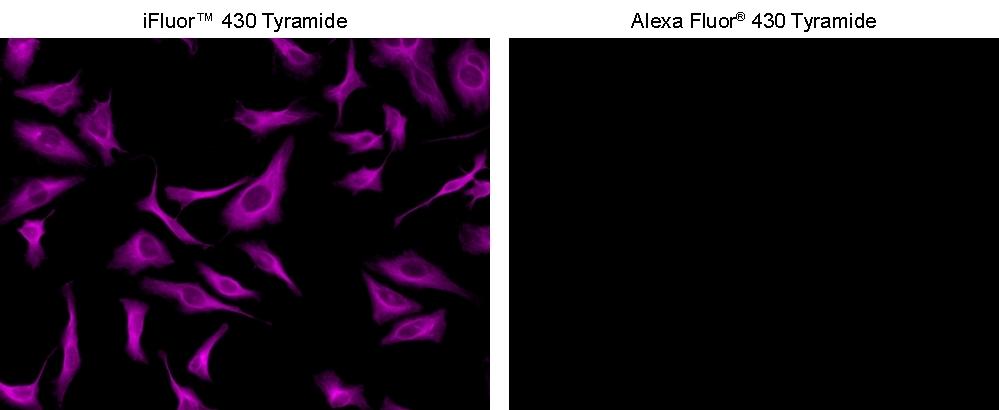iFluor® 430 Tyramide
Superior Replacement for Opal 480
iFluor® 430 tyramide is optimized to a superior replacement for Opal 480 or other spectrally similar fluorescent tyramide conjugates or TSA reagents. Tyramide reagetns can be used to detect extremely low-abundance targets in cells and tissues with significantly improved fluorescence signal than the direct fluorescence labeling reagents. In combination with our superior iFluor® dyes that have higher florescence intensity, increased photostability and enhanced water solubility, the iFluor® dye-labeled tyramide conjugates can generate fluorescence signal with significantly higher precision and sensitivity.


| Catalog | Size | Price | Quantity |
|---|---|---|---|
| 45096 | 200 Slides | Price |
Physical properties
| Molecular weight | 710.89 |
| Solvent | DMSO |
Spectral properties
| Correction factor (260 nm) | 0.68 |
| Correction factor (280 nm) | 0.3 |
| Extinction coefficient (cm -1 M -1) | 40000 1 |
| Excitation (nm) | 433 |
| Emission (nm) | 498 |
| Quantum yield | 0.78 1 |
Storage, safety and handling
| H-phrase | H303, H313, H333 |
| Hazard symbol | XN |
| Intended use | Research Use Only (RUO) |
| R-phrase | R20, R21, R22 |
| Storage | Freeze (< -15 °C); Minimize light exposure |
| UNSPSC | 12171501 |
Instrument settings
| Fluorescence microscope | |
| Excitation | Violet filter set |
| Emission | Violet filter set |
| Recommended plate | Black wall/clear bottom |
Documents
Contact us
| Telephone | |
| Fax | |
| sales@aatbio.com | |
| International | See distributors |
| Bulk request | Inquire |
| Custom size | Inquire |
| Technical Support | Contact us |
| Request quotation | Request |
| Purchase order | Send to sales@aatbio.com |
| Shipping | Standard overnight for United States, inquire for international |
Page updated on November 11, 2025

